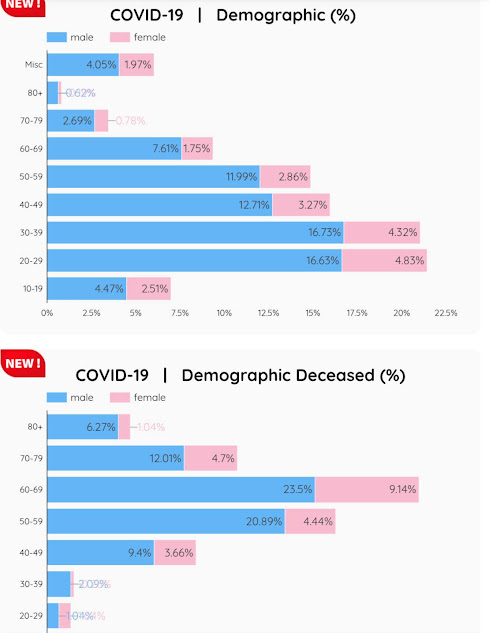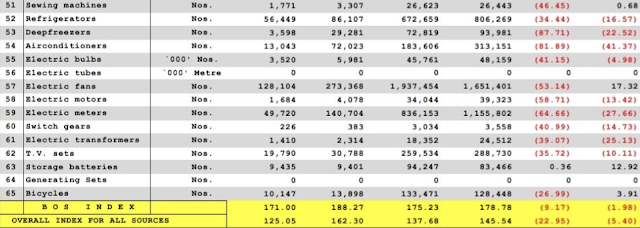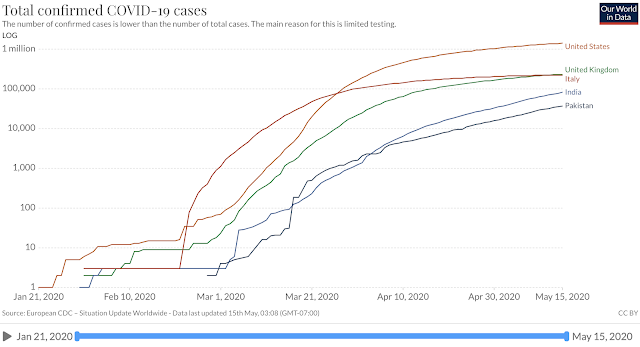PakAlumni Worldwide: The Global Social Network
Coronavirus infection rates and deaths in Pakistan are among the lowest in the world while the continuing lockdown is causing enormous damage to the nation's economy and livelihoods, according to government data. Health ministry data shows that fewer than a thousand lives have been lost to the disease in the country since the start of COVID19 infections more than two months ago. Meanwhile, millions of people in manufacturing, retail and the unorganized sectors are unemployed or underemployed. All of this is happening during Ramzan and Eid periods that account for bulk of retail sales in the majority Muslim country of 220 million. Pakistanis do not necessarily face the same level of risk from coronavirus as people living in America and Europe do.
|
Age Factor in Covid19 Mortality:
Over 40% of all coronavirus deaths in Europe and America have occurred among the elderly living in nursing homes. Pakistanis age 60+ account for 19% of cases but 58% of deaths. Like US and Europe, older people are much more likely to die from coronavirus in Pakistan. But average life expectancy in Pakistan is just 67 years and the median age in the country is only 22 years. The explanations offered for low death rates in South Asia include younger populations, more sunshine, higher temperature and humidity, universal BCG vaccinations etc. Yale researchers have argued in a recently published paper to consider universal mask adoption and increased hygiene measures as an alternative to complete lockdown.
March 2020 Manufacturing Data. Source: Pakistan Bureau of Statistics |
Pakistan Manufacturing Data:
The March figures released by Pakistan Bureau Statistics confirm a precipitous drop of 22.95% in large scale manufacturing. This reflects halt in production in just the last one week of March 2020. April 2020 figures are almost certain to be a lot worse due to complete halt in production amid lockdown. It's spelling disaster for millions of employees and households linked to these industries. Government handouts can not replace household incomes generated from these industries.
While food production held up well in March, manufacturing of durables like air-conditioners, refrigerators, and deep freezers have plummeted. For example, production of refrigerators fell 34% from 86,107 in March 2019 to 56,449 in March 2020. Number of television sets produced in March 2020 declined 34% to 19,790 from 30,788 in the same month last year.
Comparison of Confirmed Cases in Selected Countries. Source: Our World in Data |
Coronavirus Infections and Deaths:
As of May 16, Pakistan has 38,755 cases and 834 deaths. These figures are among the lowest in the world. There are many theories explaining why Pakistan and the rest of South Asia have fared much better than America and Europe. To put it in perspective, there were 31 coronavirus related deaths in Pakistan where 4,000 people die on a regular day. Any major change in daily death rates in recent weeks would not go unnoticed. While it is true that the testing rates in South Asia are low compared to America and Europe, the percentages of people testing positive and fatality rates in South Asia are also low. The explanations offered for low coronavirus infection and death rates in South Asia include more sunshine, higher temperature and humidity, younger demographics, universal BCG vaccinations etc.
Comparison of Coronavirus Deaths in Selected Countries. Source: Our World in Data |
 |
| Pakistan COVID19 Death Rate Among World's Lowest |
Social Distancing Cost-Benefit Analysis:
In a recently published paper tiled "The Benefits and Costs of Social Distancing in Rich and PoorCountries", Yale researchers support universal mask adoption and increased hygiene measures as a alternatives to social distancing and complete lockdown.
Zachary Barnett-Howell and Ahmed Mushfiq Mobarak of Yale University argue that "social distancing policies are estimated to be less effective in poor countries with younger populations less susceptible to COVID-19, and more limited healthcare systems, which were overwhelmed before the pandemic". Here's an excerpt of the Yale paper:
"Poorer people are less willing to make...economic sacrifices. They place relatively greater value on their livelihood concerns compared to contracting COVID-19. Not only are the epidemiological and economic benefits of social distancing much smaller in poorer countries, such policies may exact a heavy toll on the poorest and most vulnerable. Workers in the informal sector lack the resources and social protections to isolate themselves and sacrifice economic opportunities until the virus passes. By limiting their ability to earn a living, social distancing can lead to an increase in hunger, deprivation, and related mortality and morbidity. Rather than a blanket adoption of social distancing measures, we advocate for the exploration of alternative harm-reduction strategies, including universal mask adoption and increased hygiene measures."
Summary:
While coronavirus infections and death rates in Pakistan are among the lowest, the nation's economy and livelihoods are in serious jeopardy. With or without coronavirus pandemic, we take risks everyday when we leave our homes to go to work or school, theaters or playground, or shopping. Risks we face range from street crimes and road accidents to lightening strikes. We need to make similar assessments of risks from diseases which vary from place to place. Pakistanis do not necessarily face the same level of risk from coronavirus as people living in America and Europe do. The explanations offered for low coronavirus infection and death rates in South Asia include more sunshine, higher temperature and humidity, younger demographics, universal BCG vaccinations etc. There is a need to weigh the risk of catching coronavirus against the loss of livelihoods in places like Pakistan. Yale researchers have argued in a recently published paper to consider universal mask adoption and increased hygiene measures as an alternative to complete lockdown.
Related Links:
Vast Majority of Pakistanis Support Imran Khan's Handling of Covid19 Crisis
Pakistani-American Woman Featured in Netflix Documentary "Pandemic"
Can Pakistan Respond Effectively to Coronavirus Pandemic?
Can Pakistan Effectively Respond to Coronavirus Outbreak?
How Grim is Pakistan's Social Sector Progress?
Pakistan Fares Marginally Better Than India On Disease Burdens
Can Imran Khan Lead Pakistan to the Next Level?
Democracy vs Dictatorship in Pakistan
Pakistan Child Health Indicators
Pakistan's Balance of Payments Crisis
Conspiracy Theories About Pakistan Elections"
PTI Triumphs Over Corrupt Dynastic Political Parties
Strikingly Similar Narratives of Donald Trump and Nawaz Sharif





Riaz Haq
#Pakistan #Ehsaas program funding raised from Rs144bn to Rs203bn to soften #COVID19 impact on poor. “It means that almost half of the population of the country will be covered under the program,” says program chief Dr Sania Nishtar- DAWN.COM
https://www.dawn.com/news/1569458
Amid adverse impact of the coronavirus on the poor and people belonging to low-income groups, the government has decided to enhance the Ehsaas Emergency Cash programme from Rs144 billion to Rs203bn.
Under the first phase of the programme [of Rs144 billion] 12 million families were provided four-month stipend of Rs12,000. Now with the increase in its funds the programme will facilitate around 17m families.
“It means that almost half of the population of the country will be covered under the programme,” said Special Assistant to the Prime Minister on Social Safety and Poverty Alleviation Dr Sania Nishtar at a press conference on Thursday.
“The scope of emergency cash programme has been expanded to reach out to around 16.9 million deserving families with the increased budget of Rs203 billion,” she added.
Accompanied by Information Minister Shibli Faraz, the SAPM said initially the programme was launched on April 9 with a budget of Rs144 billion for 12 million beneficiaries.
She, however, said 12.86 million beneficiaries across the country had so far received one-time cash assistance of Rs155.64bn through emergency cash initiative as in addition to Rs144bn over Rs10bn was distributed through other resources, including the Prime Minister Corona Fund.
“The government’s largest social protection programme, Ehsaas, has taken the lead in radically expanding social safety nets to help mitigate effects of Covid-19 within Pakistan,” she added.
Terming the programme a big success of the government, she said the programme was fully transparent, rule and merit based, and apolitical. “Sindh gains the most from this programme which shows its apolitical nature,” she said while giving an indirect reply to the allegation made by the ruling party in Sindh, Pakistan Peoples Party, that the province had been ignored and its people had not benefited from the scheme.
She said as compared to initiatives taken in other countries, the Ehsaas Emergency Cash Programme gained international recognition for disbursing in time cash assistance in a well organised manner and at a larger scale.
Dr Nishtar said digital capabilities developed over the past year as part of the Ehsaas strategy had positively been adopted in making emergency cash payments.
“Requests were sought through an SMS short code service; data analytics enabled eligibility ascertainment, using unique national identification numbers and drawing on the National Socioeconomic Registry and wealth proxies (travel, taxes, billing, assets ownership data and government employment status), and payments are biometrically verified,” she explained the process of payments made under the programme.
The beneficiaries who were eligible but facing problems in withdrawing money owing to faulty biometric identification were being paid out exclusively in the designated bank branches of partner banks.
Similarly, to ease out the payment process for families of deceased beneficiaries, Ehsaas has adopted a procedure under which the families of deceased beneficiaries are required to send out an application in her name (Dr Sania Nishtar) with Computerised National Identity Card (CNIC) details of their dead family member along with those of eligible family member straight to Ehsaas offices at Islamabad.
Ms Nishtar said Ehsaas has also launched ‘Ehsaas Emergency Cash — Know Your Status’ Portal to offer an easy window to people registered with Ehsaas Emergency Cash to check their eligibility. “All applicants who have registered themselves through 8171 or Prime Minister’s Labour Portal can now easily check their eligibility status by entering CNIC number on the portal,” she added.
Jul 16, 2020
Riaz Haq
#Karachi soup kitchen has been serving hot meals for 20 years. It's been pushed to the limit in #Covid_19. It usually serves about 3,000 people a day, but in June, at the height of the #pandemic in #Pakistan, over 5,000 people showed up every day. #charity
https://www.businessinsider.com/pakistan-soup-kitchen-khana-gar-kar...
And now, in a country where 40% of the population lives below the poverty line, it has become a lifeline to thousands of struggling families during the pandemic.
At Khana Ghar, which translates to Food House, the day begins with workers rolling out dough to prepare a traditional bread called tandoori roti, which is baked in a clay oven. At lunchtime, the soup kitchen welcomes those who need a meal.
But the food is not totally free — Khana Ghar charges a token amount of 3 rupees per person, according to Parveen Saeed, who started the kitchen, which does not take a profit.
"The only logic behind it is that people are at least buying the food they are eating, so their self-respect remains intact," Saeed said. "When you give free food, people stop working. They think 'I'm getting free food for my family, and now they won't go hungry,' but when they buy it for 3 rupees, they will still work hard, earn the money, and feel like they are legitimately providing for their family."
This year, families have been talking more than ever. Make time to talk about your financial plans. Because the more we talk, the better we plan, protect and retire.
Saeed launched Khana Ghar back in 2002 after she moved to Surjani Town, a low-income neighborhood in Karachi.
A journalist by profession, she started to feed the poor after a tragic incident shook her world — a story of a local mother who killed her two children who she had been unable to feed.
"I asked her, why did you kill them?" Saeed said. "And she said one sentence: 'If your kids were hungry, you would kill them too.' That sentence can change your life, and it certainly changed mine."
"It takes me 30 minutes to get here. I walk here. I don't even have shoes, but thank God this place is here," Yameen said. "They take good care of me."
On a good day, Yameen earns 50 rupees, or 30 cents, selling plastic chairs.
But he has six children and is the only breadwinner in the family. He told us that his wife recently died from complications of COVID-19.
"I called the doctor, I called the ambulance, but my wife died in my arms," he said. "I am telling you the truth that I've really suffered."
Even death is costly these days, Yameen added, saying you need around 50,000 rupees to afford a proper funeral and burial.
Even during this trying time, Yameen says he can always count on a hot meal at Khana Ghar.
But the kitchen is being pushed to it limits. It usually serves about 3,000 people a day, but in June, at the height of the pandemic in Pakistan, over 5,000 people showed up every day.
"People said you're putting your life in danger, but we took all the precautions," she said. "We wore masks, gloves, sanitized, sprayed, and maintained social distance."
But she said that despite the challenges the soup kitchen did not stop serving food. "Poor people were telling us we will not die of the coronavirus, but what will eventually kill us is hunger," Saeed said.
With nearly 6,000 deaths in a population of 230 million people, experts say Pakistan has been spared the worst. The lockdown has mostly been lifted, and life is slowly going back to normal.
But hunger still persists. And although Parveen says that she's trying to do her best to help, it's not always enough.
Aug 28, 2020
Riaz Haq
WHO chief praises #Pakistan’s successful handling of #coronavirus #pandemic . In an Op Ed in the #UK’s “The Independent”, he writes: “Pakistan deployed infrastructure built up for polio to combat Covid-19” #COVID19 #PTI #ImranKhan | The Express Tribune https://tribune.com.pk/story/2266237/who-chief-praises-pakistans-su...
One million lives have been lost to coronavirus, but it's never too late to fight back
This milestone is a difficult moment for the world, but there are glimmers of hope that encourage us now and in the near future
Tedros Adhanom Ghebreyesus
@DrTedros
https://www.independent.co.uk/voices/coronavirus-deaths-cases-globa...
Pakistan deployed the infrastructure built up over many years for polio to combat Covid-19. Community health workers who have been trained to go door-to-door vaccinating children against polio have been redeployed and utilised for surveillance, contact tracing and care. This has suppressed the virus so that, as the country stabilises, the economy is also now picking up once again. Reinforcing the lesson that the choice is not between controlling the virus or saving the economy; the two go hand-in-hand.
Sep 29, 2020